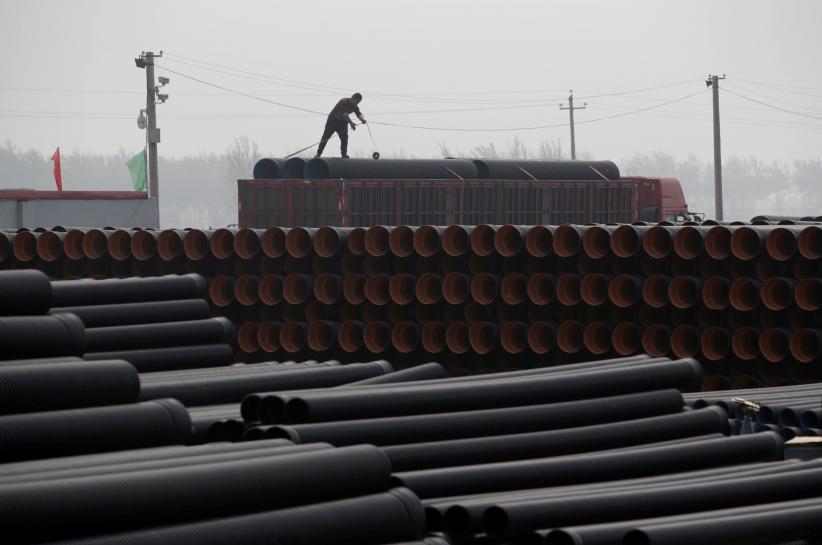
Profits earned by China’s industrial firms rose 23.8 percent in March from a year earlier, buoyed by a continued construction boom, though the pace of growth eased from multi-year highs seen in previous months.
BEIJING Profits earned by China’s industrial firms rose 23.8 percent in March from a year earlier, buoyed by a continued construction boom, though the pace of growth eased from multi-year highs seen in previous months.
Profits in March rose to 688.7 billion yuan ($99.9 billion), the National Bureau of Statistics (NBS) said on its website on Thursday.
In the first quarter, industrial profits climbed 28.3 percent to 1.7 trillion yuan, slowing from growth of 31.5 percent in the first two months but still robust enough to suggest a further recovery in fixed asset investment in China in coming months.
Higher government infrastructure spending and a frenzied housing market have helped spur sales and prices of building materials, reviving profits for the country’s long-ailing “smokestack” industries such as steel mills and smelters and giving them stronger cash flow to reduce a mountain of debt.
But firms further down the supply chain are seeing pressure on profit margins as they struggle to pass on higher input costs to consumers amid stiff competition.
“Purchasing prices are rising too quickly which is increasing pressure on companies that are trying to cut raw material costs,” NBS official He Ping said in a statement accompanying the data, adding that financial costs for businesses are also rising.
Indeed, profits of equipment manufacturers rose 6 percentage points from the pace in Jan-Feb, while profits for makers of consumer products were up just 0.5 percentage points.
Profits for miners and producers of other raw materials fell 0.9 and 9.5 percentage points, respectively, likely reflecting a recent tumble in China’s highly speculative commodities futures markets.
Shares of material companies have recoiled from their highest level since the 2015 market crash, while infrastructure stocks have pulled back from multi-month highs, though both are still up solidly so far this year.
All 13 steel companies that published first-quarter results as of April 19 reported net profits had more than doubled, the China Securities Journal said last week, with Nanjing Iron and Steel posting a surge of 4,830 percent.
Fatter profits for steel mills could make Beijing’s job tougher as it tries to reduce industrial overcapacity by closing more inefficient and heavily polluting plants.
China’s largest oil and gas producer, PetroChina, said earlier this month that it expected a first-quarter profit of 5-6 billion yuan, down slightly from the preceding quarter, but a turnaround from a huge loss a year earlier.
COOLING GROWTH
Many analysts, however, believe producer price inflation in China is peaking, which could temper profitability later this year and rob the world’s second-largest economy of some momentum.
Still, strong first-quarter profits, together with an increase of 14.1 percent in fiscal revenue, have set “an excellent foundation” for improved growth quality in 2017, Ning Jizhe, vice chairman at the National Development and Reform Commission (NDRC), told the People’s Daily in an interview on Wednesday.
China’s government has lowered its economic growth target to around 6.5 percent this year from a range of 6.5-7 percent last year and an actual rate of 6.7 percent.
First-quarter growth came in at a faster-than-expected 6.9 percent, which could give the economy enough of a tailwind to hit Beijing’s full-year target even if growth starts to fade in coming quarters as many analysts expect.
Policymakers in China are pushing a bullish message on the world’s second-biggest economy, pointing to a slowdown in capital outflows and a stable yuan after a selloff last year stoked fears of instability.
Ning told the state-run newspaper that market watchers should not be too sensitive to minor fluctuations in the economic growth rate and should pay more attention to the quality of growth instead.
Earlier this month, the International Monetary Fund raised its 2017 growth projection for the Chinese economy to 6.6 percent from 6.5 percent.
Industrial firms’ liabilities rose 6.6 percent from a year earlier as of end-March, unchanged from the pace seen in the first two months of 2017.
The profit data covers large enterprises with annual revenues of more than 20 million yuan from their main operations.
Data on Wednesday showed profits at China’s state-owned firms rose 37.3 percent in the first three months of 2017 from a year earlier.
(Reporting by Beijing Monitoring Desk and Ryan Woo and Sue-Lin Wong- Editing by Sam Holmes and Kim Coghill)
 0 comments
0 comments





